NAB and the FM in Cellphone Issue: The Disappearance of Radios
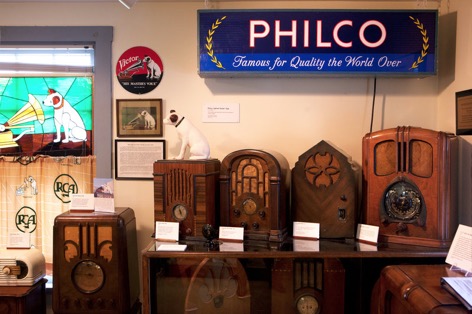
The National Capital Radio and Television Museum in Bowie, Md., is home to radios dating back to the 1920s
Photo from NPR.
Today is World Radio Day, a joint venture of ITU and UNESCO. UNESCO says
World Radio Day is about celebrating radio, why we love it and why we need it today more than ever. A day to remember the unique power of radio to touch lives and bring people together across every corner of the globe. Join the celebration!…Radio is a medium for the future. It has a duty to include young people, not just as listeners but as active producers and creators of content…In conflict and disaster zones, young international freelancers and local fixers contribute invaluably to the pursuit of information. They deserve to work in safety and security. Find out what can be done.
To celebrate this event, NPR had a piece this morning on “Finding A 'Radio That Is Just A Radio' In The Digital Age”. They sent their intrepid reporter out to buy “just a radio” - by which they meant a battery powered radio with a speaker but without a CD player, internet connection, etc. Good news is they found a convenient source even though the big box stores had nothing. Bad news is that source was Radio Shack! (However, they found alternatives available over the net.)
But this got me thinking about NAB’s past efforts in promoting HDRadio and in a statutory mandate for cell phones to include FM receivers. Earlier NAB blamed FCC for the failure of AM stereo since FCC did not immediately agree with NAB’s view of picking a technical standard. Of course, they conveniently ignore that AM stereo fizzled in other countries where the regulators kowtowed to the broadcasters and promptly picked a single standard. Just because we can build technology X does not necessarily mean that consumers want technology X.
So NAB Labs continues to discuss the availability of FM receive capability in smartphones, NAB provides a website radiorocksmyphone.com with this viewpoint:
Now, many Americans are demanding a FREE entertainment option as a feature on their smartphones – local radio! It's been around for decades, but it's better than ever – more music, more news, more choices than ever before. And best of all, it doesn't require a broadband connection or eat up your data plan.
The site has a list of “Radio Ready Cell Phones”: mostly from HTC, with a refurbished Blackberry, an Alcatel model, 2 models from LG and 3 from Samsung. (The list was last updated in June 2014 so maybe NAB isn’t taking this too seriously.)
I like radio, but I am a baby boomer not a “millennial”. Heck, I even have a ham radio license! I support NPR with donations and listening. But the way to keep radio from fading away is not to force consumers to buy a product they clearly are losing interest in; the way to preserve it is to have it carry content that people really want.
US & Japanese Broadcasters Both Try to Keep Their "Fingers in the Dike"
On Saturday the following tweet appeared from NAB Labs - “an initiative of the National Association of Broadcasters (NAB) to foster innovation and propel broadcast television and radio into the future.”

One immediate question is what really is NAB Labs? Earlier this year we speculated that “NAB Labs might appear possibly promising, but is most likely just a PR effort from a PR-focused trade association wanting the appearance of a counterpart to CableLabs.” Is NAL Labs an “initiative” or is it a technical facility? First we see that the address is the same as the NAB headquarters - near the former FCC location. Not exactly a technical hotbed area, although I miss all those nice restaurants. How big is NAB Labs? No budget information can be found. Their site gives 10 names, but policy wonk readers will recognize that several have NAB policy positions and are not primarily involved in R&D or testing.

By comparison, the similarly named CableLabs near Boulder CO has 175 employees in the building shown above. While it is unclear what the total size of the building is, it includes “over 12,000 square feet of lab space to suppliers and members who wish to use this development area.”
To give another example of how an industry develops a lab to support its members, consider the Electric Power Research Institute (EPRI), located in Palo Alto, CA - also more conducive to R&D than the Dupont Circle area. EPRI has 700 employees and an annual budget of nearly $400M. An inspection of their main office on Google Maps shows a complex with 8 buildings. So it would appear that both the CATV industry and electric power industry has “brick and mortar” labs, whereas “NAB Labs” is of a different genre.
But back to the original NAB Lab tweet. It dealt with the long standing FM in cellphone issue that has been a recurring topic here. This started as an attempt by NAB in 2009 to solve a totally unrelated copyright issue by agreeing with MusicFirst, a copyright holders group, to a package of terms that included joint lobbying for legislation to require FM receivers in all cellphones. While there has been no public discussion of such a legislative requirement recently, the new NAB Labs tweets signals something is warming up. The tweet has a link to a NAB Labs page entitled “FM Radio in Smartphones”.
NAB Labs has discovered data that
“indicates that essentially all of the 90 million smartphones sold in the U.S. during that period (2013) were equipped with an FM radio tuner, yet FM reception was activated for users in only about 4 percent of those phones. About 18 million of those phones (20 percent of the top sellers) have fully operative FM radios in their versions sold outside the U.S., indicating that FM reception could be easily activated by carriers in the U.S. versions, likely without changing the smartphone hardware.
Why does it matter? Americans are consuming more audio and video on the go than ever before. Smartphones and tablets have turned into walking entertainment centers. But the convenience of on-the-go entertainment can carry a hefty price tag as wireless companies charge by the bit. With FM radio capability, a mobile device user doesn't have to stream audio, but receives it over the air for free – with less battery drain on the device. And during crisis situations when cellular networks can go down, over-the-air radio stays on.”
Now if NAB is right, why doesn’t the marketplace work here? CTIA argues below that its does:
This continuing attempt by NAB to counteract marketplace forces sounded analogous to action by their Japanese counterparts a year ago. When faced with a new TV model with Internet capabilities that were threatening to their industry model. An English language peer in Japan reported
Panasonic says Japanese TV stations are refusing to air commercials for its new “smart” television, apparently because they feel threatened by its combined TV-Internet function.
Private broadcasters, in a rare case of turning down a major advertiser, have said they will not show commercials for the product, claiming the split screen simultaneously showing broadcast content and Web pages may confuse viewers, according to reports.
So it looks like Japanese broadcasters are also trying to put their finger in the dike to slow marketplace and new technology forces.
NAB Uses Twitter to Redact History on the FM Radio in Cell Phone Mandate Issue

While researching the previous post here on NAB’s new interest in cognitive radio, your blogger discovered the above tweets from NAB Executive Vice President of Communications Dennis Wharton on his airwharton Twitter channel. Readers may recall that a widely reported NAB push on Congress for legislation mandating FM receivers in ALL cell phone was a recurring topic here in August - October 2010. We thought NAB had just given up on the issue. No!

Was the reported push for legislation really a “myth from wireless cos”? First we have below a 2010 news item from the CBS website. Since CBS is an NAB member we assume that they are not a tool of the cellular industry. Note especially the comment at 1:05 - 1:55 of the video.
While I can’t find a public quote from Mr. Wharton supporting the legislation that would have required FM receivers in cell phones, he seemed awfully upset in August 2010 about a cellular industry letter to the Chairmen and Ranking Members of the House and Senate Judiciary Committees opposing the then pending legislation, saying “it would be unfortunate if telco gatekeepers blocked access to public safety information offered by free and local radio."
In an August 6, 2010 NAB release that “can be attributed to NAB spokesman Dennis Wharton”, it states:
At the direction of House and Senate leaders in late 2009, NAB met with MusicFirst - representing artists, labels and unions. To date discussions have yielded the following potential terms. These terms have NOT BEEN AGREED TO, but are under discussion by the industry.
They include:
-Tiered rate of 1% or less for all net revenue (roughly $100 million for the industry) which is permanent and can not be adjusted without changing statute or by mutual agreement
-PERMANENT removal of CRB jurisdiction for terrestrial and streaming
-Streaming rate reduction from current rates
-Inclusion of radio chips on all mobile phones
-AFTRA issues resolved (agency commercial replacement on webcasts)
Note the next to the last item, “Inclusion of radio chips on all mobile phones”. Thus NAB stated in 2010 that it was discussing an FM radio mandate as part of a package of items with the music industry group MusicFirst to settle a music copyright dispute between them. So while in some strict sense NAB never formally agreed to the specific package of terms that included the FM mandate, the phrase in Mr. Wharton’s June 6 tweet about a “cellphone mandate that no one is pushing” seems less than candid.
It is clear that NAB was pushing this mandate in August 2010, it just never agreed on final package with the music industry. At the time NAB publicly disagreed with the cellular industry on the need for a mandate - they never denied their support for it until this current series of tweets.
NAB was perfectly happy to put this mandate on the cellular industry and consumers who have voted “with their feet” not to buy the few models of cell phones that include FM receivers. Perhaps if the broadcasters put some compelling content on their stations they might get listeners without mandates. NAB also has pressed FCC for HD Radio mandates to help prop up that technology that consumers are rejecting.
NAB, I’m sure you are good Republicans who object to the “Obamacare” insurance mandate. Why are you pushing all these other mandates and then denying it?
(For the record, your blogger is an avid NPR listener and a paid member of WAMU-FM.)
UPDATE
CTIA has now jumped in with this YouTube video dumping on NAB on this issue. (Note that CTIA says on 2 out of 20 people interviewed said they used their cell/smart phone to listen to FM. However, their is no indication of how many had that option since few cell phones at present have the capability. It really was an unfair question, although I think a fairer question would have got the same answer.)
I would love to moderate a public discussion between Mr. Wharton and Mr. Walls on this issue!
CTIA has now created a Twitter hashtag #nofmchipmandate . So if you need constant updating on how silly two powerful trade associations with million dollar CEOs can behave, just enter this into your favorite hashtags list and watch the silliness in real time!
NAB vs. CTIA: Citigroup Report

[Note: As of 10/7/11 NAB has removed this link to the report from their website. We have asked NAB for an explanation.]
Last week we mentioned how CTIA and NAB were fussing at each other over the relatively minor issue of FM receivers in cell phones. (An issue where this blog has consistently supported the CTIA viewpoint.) But this week the inter trade organization feud has escalated to the big issue: spectrum. With their million dollar CEOs, these 2 goliaths are out for blood to impress their memberships. Now NAB isn’t exactly up to date with the today’s nonbroadcast media. Their Policy Blog’s last entry was July 11 and has only had 5 posts this year! (CTIA’s blog by contrast has almost daily posts and sometimes 2/day.
(NAB’s use of Wordpress’ domain rather than their own domain for the blog is something a web savvy high school student would be embarrassed about. Poor NAB, the obvious Twitter name , @NAB, was already taken by National Australia Bank, but CTIA was able to get @CTIA for themselves. NAB was able to get #NABShow and statements from NAB appear from @NAB Newsroom, and @AirWharton in case your Twitter feed needs more input.)
NAB sent the news media the Citigroup report whose front page is shown above but as of this writing has not said anything on their own website about it. Wireless Week published a post with the eye catching headline: “Citigroup Report Discredits Spectrum Crunch; CTIA Fires Back”. They go on to write,
Citigroup says the U.S. wireless industry isn't facing a spectrum shortage and needs to do a better job managing the bandwidth it already has.
The report claims that wireless operators and other spectrum holders like cable operators are using only a portion of their spectrum to provide wireless services.
Citigroup's analysis was made public by the National Association of Broadcasters, which has been at odds with the wireless industry over an FCC proposal to auction off additional television airwaves for mobile broadband service.
Here are Citigroup”s conclusion (p.27)
•Mixed Signals — Robust Smartphone and tablet sales suggest wireless demand is growing rapidly. And, the FCC suggests the US faces a long-term spectrum shortage. However, several new wireless carriers - Clearwire, LightSquared and Dish - have been slow to light-up their spectrum suggesting excess supply. So, who's right? Isthere a spectrum shortage or not?
•Spectrum Availability High, Use Low — Today, US carriers have 538MHz of spectrum. And, additional 300MHz of additional spectrum waiting in the wings. But, only 192MHz is in use today. And 90% of this in-use spectrum is allocated to 2G, 3G and 3.5G services. As such, we estimate carriers can only offer average wireless speeds of 0.5-1 mbps during the peak busy hour.
•But, Spectrum Is in the Wrong Hands — Too much spectrum is controlled by companies that are not planning on rolling out services or face business and financial challenges. And, larger carriers cannot readily convert a substantial portion of their spectrum to 4G services, because most existing spectrum provides 2G-3.5G services to current users.
•Full 4G Can Deliver 5Mbps — 100% conversion of 538MHz allows carriers to offer 5Mbps with 10% simultaneous usage during peak busy-hour. This speed allows for very robust mobile use and limited home use. However, it is not sufficient for in-home replacement capable of large screen HD video streaming.
•Bottom Lines — We do not believe the US faces a spectrum shortage. However, unless incumbent carriers accelerate their 4G migration plans, or acquire more underutilized spectrum, upstart networks – like Clearwire, LightSquared and Dish – could have a material speed advantage over incumbent carriers provided that they can clear meaningful hurdles for funding and distribution
While NAB has no statement as yet on the report, CTIA certainly does:
“As we have said multiple times in the past, and has been recognized by a bipartisan group of lawmakers in the House and the Senate, the President, and the Chairman of the FCC, there is a need to bring additional spectrum to market to fuel what is one of the country’s key industries. Other countries have recognized the need to fuel their mobile ecosystems and have identified hundreds of megahertz of spectrum for mobile use. Our member companies would not be lining up to spend billions of dollars at auction for the right to use this spectrum if there was not explosive consumer demand for mobile broadband services.
“We need to move past NAB’s efforts to attack what everyone around the world already knows – that mobile broadband usage is exploding, and more spectrum is needed to continue to drive benefits for citizens that even five years ago were unimaginable.
“This time, NAB points to a report to conclude that there is no spectrum shortage. Aside from our concerns with several of the data points in the report, the most amazing element of the report that NAB fails to consider is that the authors of the study INCLUDE 120 MHz of reallocated broadcast spectrum in their analysis, when they talk about spectrum availability being ‘high.’ Page 2 of the report says that an additional 300 MHz of spectrum is ‘waiting in the wings,’ and 120 MHz of which is the very broadcast spectrum that the FCC has proposed to reallocate and that Congress is considering for incentive auctions. CTIA looks forward to working with Congress to ensure that there is in fact sufficient spectrum brought to market.”
And CTIA also has 2 recent tweets proclaiming the need for more mobile spectrum. So while we will not take this opportunity to take sides, it is clear that CTIA is the master of the new media for getting their word out!
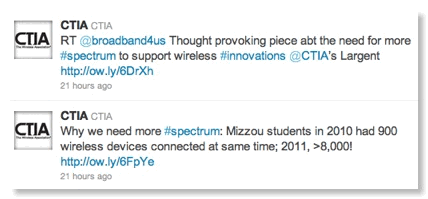
UPDATE
So NAB did not release publicly any comment on the Citigroup report, just posted it on its website although now even that is gone!
However, an e-mail yesterday from NAB revealed their latest actions in this area: a letter from NAB President and CEO Gordon Smith to members of the Joint Select Committee on Deficit Reduction regarding the conclusion of a Citigroup study that there is no spectrum shortage affecting the wireless industry. In addition, an ad regarding the study in Capitol Hill publications.
Here is CTIA’s response released publicly on their website and blog:
"If this is how the NAB is showing their support for voluntary incentive auctions, then I would be fascinated to see how they'd respond if they opposed the idea. Frankly, I would imagine their messaging would look and sound like this letter. To be clear, ALL the proposals on incentive auctions are voluntary.
"Throughout this process, the NAB has consistently misrepresented the facts, with their efforts becoming more desperate as time goes on. The looming spectrum crisis is a fact that has been acknowledged by the president, members of Congress and the FCC Chairman and his colleagues. It has been acknowledged by foreign governments. The only people on the planet who consistently fail to acknowledge its existence work at the NAB.
“The fact is, America’s future is wireless. Consumers want the products and services they want, when they want them. This is a scheme that reflects the wireless broadband model far more closely than it reflects the broadcast television model, which is essentially the same as it was when Philo Farnsworth invented the TV in 1929.
“For the good of our members, American consumers and the American economy, Congress must act this year to make additional spectrum available for wireless broadband services.”
So we can see that CTIA is more transparent about their lobbying while NAB prefers to work in the shadows.
FURTHER UPDATE
CTIA bog post: Citigroup vs. Engineering: I’ll Take Engineering
CTIA Mum on NTSB Cellphone in Truck Recommendation
To the 50 states and the District of Columbia:
Enact legislation to prohibit cellular telephone use by commercial driver's license holders with a passenger-carrying or school bus endorsement, while driving under the authority of that endorsement, except in emergencies.
In its investigation, NTSB made this finding:
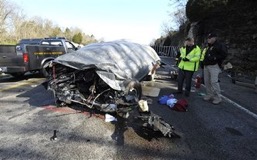
While CTIA recently had plenty of time to make 2 blog posts (1 2) responding to NAB’s latest tirade on the silly FM chip in cellphone issue, more than a week after the NTSB recommendation to ban cell phone use by truckers CTIA remains silent on the issue. (Note that your blogger has repeatedly agreed with CTIA on this relatively minor issue.) Indeed, the CTIA image machine was able to get the first blog post on the FM/cellphone issue out the very same day as NAB’s statement and the second the next day. Both with matching tweets!
The cellular industry does many good things in our society and can be generally proud of its public service record. But the issue of cell phone use in driving is a real public safety issue where CTIA has focused solely on texting and “inexperienced or novice drivers” -- putting it on the other side of the issue from both DOT and NTSB.
Perhaps CTIA feels that if it ignores the NTSB recommendation it will go away. Note that his view is not monolithic in the cellular industry. Sprint continues to be a sponsor of Oprah’s No Phone Zone program.
So, FCC and other CTIA members: Is the marginal revenue gained by ignoring distracted driving and lobbying against regulations to control it really worth it? Does it really have to diminish your other good works?
DOT video on dangers of distracted driving
Video from Oprah on distracted driving
UPDATE
Shortly after this post went up, we heard from CTIA:
Actually, we did have a statement. Here is a statement to attribute to John Walls, vice president of public affairs for CTIA--The Wireless Association:
"Accidents that involve any of the numerous driving distractions are unfortunate, and those resulting in loss of life are tragic. The wireless industry has been educating drivers about the dangers of distracted driving for more than a decade, and does not oppose legislation that restricts the use of wireless communication by drivers."
At the time of the blog post a search of the CTIA website for "NTSB" gave no hits at all. Nor was Mr. Walls' quote available on either the CTIA blog or under press releases. Indeed, a search for the words in the statement had not hits on the CTIA site strongly implying it was not publicly available.
So we welcome this statement that the industry "does not oppose legislation that restricts the use of wireless communication by drivers". However the current CTIA position statement on safe driving does not have Mr. Walls’ general concept of nonopposition to driver restrictions - it only deals with manual texting and “younger drivers”. Let’s hope that CTIA continues to move away from opposing safety-related restrictions and even actually supports the NTSB recommendation.
"A Cure for the (Broadcast) Radio Industry" - NYTimes
I have been a fan of the The New York Times’ David Pogue for a long time. He always writes witty and accurate pieces about the latest IT gadgets and trends. The above piece appeared recently on The Times website and deals with a possible evolutionary path for radio broadcasting, which is not doing well in the Internet age. The broadcasting establishment tried HD Radio as as way to breath life into AM/FM. Thinking that the problem with AM stereo was the way FCC failed to pick a standard, they bullied FCC into picking a standard for HD Radio. Of course, they failed to notice that AM stereo was a worldwide failure - failing even in countries and regions where Soviet-style planning decisively picked a standard. HD Radio may well be heading to the same fate.
The video above describes DAR.fm, a new website that overs a web-based Tivo-like service for hundreds of AM and FM stations. Pogue is optimistic that this service could stimulate demand for content from existing radio stations. Note, however, that NAB seems more interested in their weird attempt to force the CTIA crowd to put broadcast radio receivers in cell phones. We haven’t heard anything about that in a while, perhaps the Congress that is mad about Obama allegedly mandating a phase out of incandescent light bulbs (Bush 43 actually signed the legislation with bipartisan support) is also wary about a new mandate on consumers.
NAB and CEA at Each Other Again Over Cell Phone FM Radio Mandate
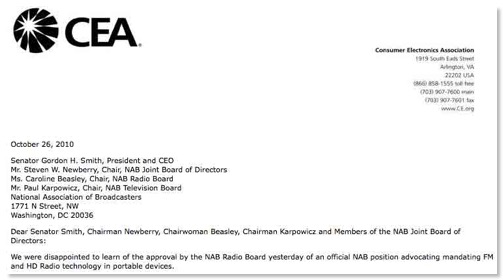
I had thought that NAB’s ludicrous proposal to mandate - by federal law - FM receivers in all cell phones (and possibly other mobile equipment)was either a late April Fool’s prank or a kind gift to bloggers to give them something to write about in August. Doesn’t NAB listen to their own newscasts about how the electorate is fed up with the growing role of the federal government and its intrusion into our lives? Isn’t Fox represented on the NAB board? (Indeed,Jack Abernethy, CEO, Fox Television Stations Inc. is on the NAB Board. Rupert M., remember you called me twice in the 1990s trying to arrange a rendezvous with Chmn. Hundt in Hong Kong? I tried hard to arrange it. Could you return that effort by talking to Mr. Abernethy about this? If you’re too busy perhaps you could ask Glenn Beck to call him for you?)

It’s back for Halloween!
Tuesday NAB released a summary of actions at its 10/25-26 board meeting cryptically announcing:
PERFORMANCE FEE DISCUSSION AND ACTION
The NAB Radio Board voted in favor of presenting musicFIRST representatives a legislative "Term Sheet" designed to resolve the longstanding performance fee issue. The Radio Board conditioned their support for the Term Sheet on the understanding that all provisions would remain part of any legislative package.
The cryptic NAB wording was explained by Politico reporter Jennifer Martinez in an article on Thursday:
The board of the National Association of Broadcasters voted this week in favor of paying musicians a royalty fee for playing their music over the radio.
But there’s a catch: If Congress doesn’t vote to force mobile phones to come equipped with radio tuners — a measure that the wireless and consumer electronic industries vehemently oppose — the size of the royalty fee would ultimately depend on the percentage of U.S. mobile phones with built-in radio tuners.
Although CTIA has been quiet publicly on the issue, CEA hasn’t been this week. The recent NAB/CEA DTV Transition cooperative spirit now seems like ancient history. The letter shown at the top of this post was lobbed across the Potomac from CEA’s Arlington bastion to NAB’s DuPont Circle fortress on Tuesday. CEA writes:
We realize that you are under pressure from the RIAA, musicFIRST coalition and Congress, but assure you that your strategy of using us to kill this legislation is failing. Members of Congress rightly judge their constituents to be in no mood for government mandates or interference with the marketplace. We have yet to identify one member of Congress willing to support your attempt to impose old FM technology on new portable products. As the representatives of an innovative and forward-looking industry, CEA will vigorously oppose any effort to force manufacturers by legislative fiat to include legacy technology in devices.I therefore write to urge you to reject this proposal and work instead toward a marketplace solution.
If you insist on taking this proposal to Congress as approved by the NAB Radio Board, we will continue to point out the following:
• Radio is a legacy horse and buggy industry trying to put limits on innovative new industries to preserve its former monopoly. The industry’s refusal to innovate to the benefit of consumers raises questions about the ongoing wisdom of broadcaster use of publicly owned spectrum that could better be used for broadband services that serve the public interest.
• At a time when popular new digital media platforms like satellite radio and online music services are required to pay performance royalties to copyright owners, it is unclear that the royalty exemption for broadcast radio stations can be justified. Indeed, fairness requires that the royalty rate paid by broadcasters should the same as that assessed to online music streaming services and other new technologies.
• Many local radio stations are unmanned, particularly at nights and on weekends, rendering the alleged emergency alert benefit of FM tuners in mobile phones unreliable and raising questions about the wisdom of permitting such unattended operation.
• The additional inclusion of HD radio in the proposal will likely be harmful to manufacturer enthusiasm for and adoption of this technology.
• The threat to make this a step toward a similar requirement for mobile TV implied by Senator Smith in the town hall meeting will quell this nascent market and diminish TV makers’ enthusiasm for mobile products.
We do applaud your recognition of political reality that this proposal is dead-on-arrival on Capitol Hill and your willingness to embrace a more marketplace approach toward compensation. Indeed, we keep hearing from NAB members uncomfortable with the technology mandate approach.
Rarely does one see this type of candor and threat in a public letter from one massive trade association to another. I hope that the TV members of NAB realize that the simultaneity of this FM/cell phone dispute and the Cablevision/Fox dispute during the World Series is a PR disaster for broadcasting as a whole. They are lucky that the election news is limiting coverage somewhat.
Here is Ars Technica’s analysis of the CEA letter:
There's a lot to parse here. The first paragraph appears to threaten to oppose the whole concept of analog broadcasting itself, or at least to encourage Congress and the Federal Communications Commission to extend its relentless search for 500MHz of new licenses for wireless broadband to the FM radio zone (88-108MHz). Thus far that band hasn't been part of the scenario.
The second raises the specter of reviving the FCC's pretty much dead-in-the-water localism proposals, which recommend making the nation's largely automated broadcast stations staff their operations 24/7 ("staff" as in "with human beings").
Ironically, while the broadcasters are quite enthusiastic about mandates for other industries, they're implacably opposed to mandates for themselves—such as minimum staffing and hours for local programming, or a rule requiring license holders to keep their "main studio" in their signal area.
In any case, the record industry is not impressed with NAB’s new “compromise”:
MusicFIRST has completed a preliminary analysis of the new term sheet. In it the radio broadcasters unilaterally cut their digital royalty rates and lowered their terrestrial royalty payment. Those changes by themselves undermine the fundamental economic equation that was core to the July agreement. The NAB’s term sheet gives the idea of a sweetheart deal a bad name. It might even be worse for the music community than the status quo.
Fortunately, Congress writes the laws, not trade associations like the NAB. The musicFIRST Coalition will continue to press forward.
But perhaps the root causes of this problem are the overly macho trade association CEOs who try to justify their high salaries by erratic actions rather than acting like statesmen for their industries. Perhaps a pay cap on such CEOs would help return reason to telecom policy deliberations. Maybe Jon Stewart will propose that tomorrow.
NAB and RIAA - Thanks for Creating Some Exciting News in the Normally Quiet August
Telecom and techie bloggers would normally have little to do during August when both FCC and Congress basically go on vacation. But fortunately NAB and RIAA have taken this normally dull news period and made it exciting with their proposal to require all cell phones -- and possibly other types of personal electronics -- to include what you have always been yearning for: an FM receiver! We bloggers are very grateful to NAB and RIAA for their help at this normally quiet period.
The picture at top is from the CBS News website where a CNET commentator really cuts into the proposal predicting that once Steve Jobs hears about it, he will just kill it since he is Master of the Universe. (Does CBS risk being kicked out of NAB for hosting such heresy?)
In memory of the late Fairness Doctrine, here as a link to the Radio Business Report/Television Business Report “Voice of the Broadcasting Industry” website which has a more rational discussion of the topic than NAB who declared the wireless industry’s letter to Congress to be “anti-radio”. (Fortunately, this blog has never been labeled with that dread description.)
However, RBR comes up with a surprising piece of legal research: “Remember also, the Communications Act of 1934 enables the FCC without Congressional intervention to set all of the technical standards for radio receivers, let alone two-way radio receivers -- a.k.a. cell phones.” Even NAB’s well respected legal staff was not able to come to this conclusion simply because there is no such provision in current legislation! (We will gladly print any input arguing otherwise)
But, the other side makes much more interesting reading:
Digital Tends: Will Uncle Sam Shove an FM Radio in Your Cell Phone
AppleInsider: NAB, RIAA seek to push FM radio into iPods and iPhones
Public Knowledge: Despite the RIAA/NAB Unholy Alliance to Force FM Radios Into All Cell Phones, Performance Royalties Are Still a Good Idea
ExtraTorrent: RIAA Demands Cell Phone Makers to Install FM Tuner
Daily Tech: RIAA and Broadcasters Look to Tell U.S. Government to Mandate Radios in Cell Phones
”Whether it's suing dead people or simply suing living ones for millions of dollars for illegally downloading a few tracks, media watchdog the Recording Industry Association of America (RIAA) seems to gravitate towards controversy like a moth to a flame. The divisive organization is back at it again, this time demanding that the U.S. government impose a drastic mandate on cell phone production.”
techdirt:
Will The NAB Agree To A Performance Rights Tax In Exchange For Having RIAA Support Mandatory FM Radio In Mobile Phones?
(from the rearranging-deck-chairs dept)
We've discussed, for quite some time now, the ridiculousness of a performance rights tax on radio. This is the attempt, by the record labels, to get radio stations to pay performers for advertising and promoting their music. This is clearly not needed, because in the real world, without this, record labels already know that radio play is valuable: it's why they keep running payola scams. For them to try to then legally mandate that money should flow in the opposite direction is downright ridiculous. In what world does the government make someone pay to promote someone else?
After years and years fighting this, we should have known that the NAB would come up with some ridiculous idea in the end. The NAB, which represents broadcasters, is almost always on the wrong side of policy debates (that's what happens when your job is to protect a dying industry), but on this one issue we agreed... until now. Rumors are circulating that the NAB is willing to cave on performance rights, if the RIAA, in exchange, supports a totally wasteful plan to require FM radio receivers be placed in mobile phones, MP3 players and other digital devices. Now, everyone involved says no deal is done yet, but there are multiple indications that this is exactly where the conversation is heading.
So congratulations to NAB for getting this publicity in August that you really could not even buy! We hope your TV members appreciate how this action shows positively on the whole broadcast industry and its dedication to public service. MSTV must be happy that the “good cop/bad cop” dichotomy between the two organizations is diminishing with NAB’s bold legislative proposal for its radio members.
But in the interest of breaking this log jam, here is a bold new proposal from your blogger: Anti immigrant fever is now very popular and any real control of the “undocumented” will require a national ID system, mandatory carrying of such an ID, and regular spot checks - without ethnic profiling, of course. Why not just combine an FM radio mandate with the a new national ID card!
The RadioMuseum website shows a 1986 Casio FM receiver that is as large of two credit cards stacked on top of each other. Certainly with the technical progress of the past 14 years this can be reduced to maybe 1.5 credit cards (or less) and could also have a high tech national ID card incorporated. Then everyone will be required to carry an FM receiver subject to arrest by Sheriff Arpaio for not carrying it. Wouldn’t that be better than just the proposed NAB/RIAA cell phone mandate? You would be arrested for not carrying an FM receiver! Law enforcement could check for both FM radios and undocumented aliens at the same time. That would be real government efficiency addressing 2 key goals at the same time.
UPDATE: NAB Fights Back!
ZeroPaid.com: Radio Pres: Forced Cell Phone FM Tuner is “Pro-Consumer”
National Association of Broadcasters executive vice president Dennis Wharton blasts critics for using usual “Washington-style tactics” that are “long on exaggeration, rhetoric and factual inaccuracies,” and cites evidence of a growing radio audience as proof that “cell phone subscribers deserve access to radio’s free service.” Says opposition is a “simple case of anti-competitive behavior.” ...
I think he’s trying to paint critics with the Washington tag in order to make them seem outside the mainstream, but I think it’s safe to say that most critics are average folks leery about govt mandating design requirements instead of the likes of tech companies like Apple or Motorola. If consumers really wanted an FM tuner they’d seek out those handsets that have them.
But the new winner of the most humorous treatment of this mess is ZatzNotFunny.com for some clever artwork:

Bang out Morse code distress messages from your Sprint EVO MC
Sounds of Silence
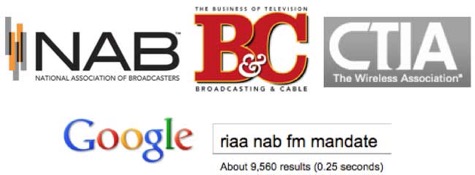
As shown above, Google can find lots of information about the “wacky idea” of NAB and RIAA to mandate FM receivers in cell phones and certain other personal electronics to help settle their music royalty dispute. I’m sure most Americans would be glad to pay extra to carry around something they don’t want and makes their cell phone bulkier in order for these trade associations to kiss and make up. Most Americans feel trade association comity is a key issue and would be glad to help out.
Oddly, three usually very talkative entities, shown above, are strangely silent on the issue. CTIA is reported to be against the proposal, but their website is silent. Broadcasting & Cable, the broadcasting industry’s cheerleader - masquerading as journalism - is also devoid of information.
Finally, coconspirator NAB is also strangely silent on the issue of FM receivers, although they have a page on the “Performance Tax” issue that lead to the bizarre deal with RIAA. The ad at left was part of NAB’s campaign on this issue. Glad to know that they don’t “need a bailout” from the government. An unnecessary mandate on consumers would be adequate to appease NAB.
NAB’s website discussion ends with this:
Action Needed
Congress should oppose a congressionally mandated performance tax on free, local radio broadcasters that would jeopardize local jobs, prevent new artists from breaking into the recording business and harm the 239 million Americans who rely on local radio.
Doesn’t mention that FM receivers in cell phones are part of the solution. Maybe the news of the deal leaked before the NAB spin doctors could tidy up their website.
We will be glad to print or link NAB’s explanation when they figure it out. I am sure B&C will echo it as soon as they get their marching orders from 1771 N Street NW.
CTIA’s silence is more puzzling. Perhaps they are trying to negotiate and don’t want to be as confrontational as CEA.
UPDATE 1
While writing this I tried to call NAB for an opinion/statement, but just got routed from one person to another. However, an e-mail inquiry produced
following quote from NAB Executive Vice President of Communications Dennis Wharton.
"We think that from a public safety perspective, it is critically important to have broadcast radio’s unparalleled lifeline service available instantaneously in times of emergency. For that reason, NAB would oppose any legislation related to royalties that did not include that feature.”
On background, a few things to keep in mind:
-- Radio is a reliable, free and local lifeline service in times of crisis, and in a society where cell phones and other mobile devices are increasingly ubiquitous, it makes sense to have radio-enabled chips in these devices from a public safety perspective; Not to get too dramatic about this, but there were photos that I wish I’d saved from the NY Times on 9/11 of people huddled around car radios and boomboxes to get the latest information;
-- When mass-produced, this feature would cost pennies per cellphone;
-- Many cellphones already have radio capability. They have just not been activated yet by the manufacturer;
-- “Tagging” of music is a feature that many consumers would enjoy, possible providing a new revenue stream to cellphone providers, record labels and radio stations;
-- Putting an FM chip in a cellphone frees up network capacity for the cellphone provider that was previously employed by the consumer for streaming audio features like Pandora and iHeartRadio.You might also be interested in the attached letter, sent last November, by 60 U.S. House representatives from both sides of the aisle to FCC Chairman Julius Genachowski and Secretary of Homeland Security Janet Napolitano. The letter advocates that FM radio capability be added to all mobile phones sold in the United States, citing safety and emergency warning alert concerns. (See attached)
NAB’s Wharton told the Washington Post’s Rob Pegoraro in an e-mail:
From a public safety perspective, it is critically important to have broadcast radio's unparalleled lifeline service available instantaneously in times of emergency. For that reason, NAB would oppose any legislation related to royalties that did not include that feature.
Pegoraro commented in the Post:
Somehow, the broadcasters did not think to make such a request earlier, even though an entire generation of Americans has grown up thinking "phone" means "mobile phone." So either the NAB has only recently begun to put a higher value on human life, or it thinks spending other people's money--that of phone manufacturers, the carriers who sell their products and their customers--will sell this proposal to its members.
Kristopher M. Jones, NAB Vice President, Media Relations added “One last thing: The assertion that radio is a "horse and buggy" dying technology is belied by Arbitron, which recently reported that the number of over-the-air radio listeners per week is now at an all-time high, at 239 million. That’s up 7 million in just the last year. http://arbitron.mediaroom.com/index.php?s=43&item=693 “
NAB: The “November” letter, actually September 2009, got no attention in the broadcasting press, not even it its lapdog Broadcasting & Cable. If FM broadcasting is doing so well, why do we need this mandate? Chmn. Genachowski has responded to the Congressmen who sent the letter saying that the issue will be folded into an ongoing docket on Commercial Mobile Alert System, Docket 07-287. He also stated,
“As you may be aware, on April 9, 2008, the Commission released its First Report and Order adopting technologically neutral rules for the CMAS. In that Order, the Commission considered the comments filed by supporters of FM-based emergency alert technologies, and ultimately concluded that it would "not require or prohibit the use of ALERT-FM ... or similar systems as the basis of the CMAS." CMAS participants, then, are free to adopt FM-based technologies as they desire.”
So, NAB, why do we need legislation at this moment? What is wrong with the current technological neutrality? What does RIAA and “performance tax” have to do with this? What relationship does royalty legislation have with public safety? Isn’t this just a bailout - the thing you decried in your ad?
I was hoping to listen in in the 8/23 NAB “virtual town hall” on radio issues, but sadly they have now closed it to nonmembers.
UPDATE 2 8/24
NAB finally broke its silence on its website with the following item:
NAB Statement on CTIA's Anti-Radio Letter to Lawmakers
The National Association of Broadcasters issued a statement today in response to a letter sent by several wireless industry representatives to the Chairmen and Ranking Members of the House and Senate Judiciary Committees. The groups expressed their opposition to the adoption of a radio receiver in cell phones.
Commenting on the letter, NAB Executive Vice President of Communications Dennis Wharton issued the following statement:
"Countries around the globe have added radio-enabled cell phones that are increasingly popular with consumers. The reality is that 239 million Americans tune in to free and local radio every week, and seven million new radio listeners were added just last year.
"Day in and day out, local radio stations serve as a reliable lifeline in times of crisis and weather emergencies. In an increasingly mobile society, it would be unfortunate if telco gatekeepers blocked access to public safety information offered by free and local radio."
The National Association of Broadcasters issued a statement today in response to a letter sent by several wireless industry representatives to the Chairmen and Ranking Members of the House and Senate Judiciary Committees. The groups expressed their opposition to the adoption of a radio receiver in cell phones.
Commenting on the letter, NAB Executive Vice President of Communications Dennis Wharton issued the following statement:
"Countries around the globe have added radio-enabled cell phones that are increasingly popular with consumers. The reality is that 239 million Americans tune in to free and local radio every week, and seven million new radio listeners were added just last year.
"Day in and day out, local radio stations serve as a reliable lifeline in times of crisis and weather emergencies. In an increasingly mobile society, it would be unfortunate if telco gatekeepers blocked access to public safety information offered by free and local radio."
(NAB was not specific as to which “anti-radio” letter they were so upset about. Absent a more specific citation, it appears to be this one.)
Also newsworthy is a post on the Public Knowledge site that starts:
There’s an absolutely ridiculous story making the rounds—apparently the NAB and the RIAA have come to an agreement whereby the NAB will support broadcasters paying performance royalties, in exchange for the RIAA supporting a legal requirement that cell phones, mp3 players, and the like have FM receivers built in.
This idea is so bad that it practically debunks itself—see discussion here, here, and here—but it should suffice to say that it would probably be cheaper to buy every man, woman and child in these United States a portable transistor radio, than to wastefully redesign every high-tech gadget so that it supports an obsolete technology nobody wants. Better yet, let’s auction off the FM spectrum and use the proceeds to buy everyone a pony. ...
The NAB isn’t exactly known for its consistent policy positions (see, for example, its fierce opposition to the XM/Sirius merger (non-NAB members, coincidentally), and its support for every other media merger ever), but blackmailing the RIAA into supporting such a laughably stupid idea as requiring that cell phones include FM tuners is a new low.
NAB vs. Economic Darwinism


Music labels and radio broadcasters can't agree on much, including whether radio should be forced to turn over hundreds of millions of dollars a year to pay for the music it plays. But the two sides can agree on this: Congress should mandate that FM radio receivers be built into cell phones, PDAs, and other portable electronics.
The Consumer Electronics Association, whose members build the devices that would be affected by such a directive, is incandescent with rage. "The backroom scheme of the [National Association of Broadcasters] and RIAA to have Congress mandate broadcast radios in portable devices, including mobile phones, is the height of absurdity," thundered CEA president Gary Shapiro. Such a move is "not in our national interest."
“Rather than adapt to the digital marketplace, NAB and RIAA act like buggy-whip industries that refuse to innovate and seek to impose penalties on those that do.”

This effort is reminiscent of NAB’s pressure on FCC during the Sirius/XM merger that resulted in FCC’s odd Notice of Inquiry captioned “In the Matter of Development of Devices Capable of Supporting Multiple Audio Entertainment Services”, Docket 08-172. Pandering to NAB pressure, FCC asked about
“ requiring devices capable of receiving SDARS to include digital audio broadcast (“DAB”), or HD RadioT, or any other technologies capable of providing audio entertainment services; and requiring devices capable of receiving HD Radio to include SDARS or any other technologies capable of providing audio entertainment services.”
In that NOI FCC presented no legal basis at all why they might have authority to adopt such a regulation. In its comments (at p.9), NAB only cites Section 7 of the Communications Act. Besides the fact that the Commission has consistently ignored Section 7 since it was adopted in the 1980s, a simple reading of the text shows no basis for such authority.
So having promoted HD Radio as new technology for saving FM’s franchise -- with little net effect, NAB is now looking to Capitol Hill as salvation for its radio members. Why not try making the programming more interesting/compelling?
UPDATE
• It gets more bizarre. It appears that the NAB/RIAA proposal/deal is not a free standing one, but part of a larger compromise package by the 2 groups on music royalties and involves streaming audio services. AppleInsider explains,
Currently, only songwriters are paid performance royalties for music played by over the air radio stations, although satellite and Internet radio stations are required to pay performance fees to the artists and labels as well.
Negotiations between the two trade groups have found agreement on a plan that requires radio stations to pay new, limited performance rights fees to the studios annually, but that plan is tied to the ability of the two groups to pass laws forcing mobile device makers to add FM radio features to their devices.
It also reduces the jurisdiction of the Library of Congress’ Copyright Royalty Board with respect to terrestrial broadcasting and streaming. While NAB and RIAA were working out their problems, they thought they would put the FM “chip” requirement on consumer systems unrelated to the problem at hand -- perhaps to preserve their “buggy-whip” business as CEA would say.
• Ars Technica now reports that CEA members might back off from their objections if they are “paid off”. This is a good example of why the public interest is not always what the directly affected parties can negotiate among themselves.
FierceMobileContent.com article
PublicKnowledge article
WirelessWeek article
Winner of most humorous article award: TinyMixTapes.com. A sample:
There has been a bitter war between the armies of music and radio. The taxes that the Recording Industry Army of America (RIAA) demand of radio duchies across the country remains a contentious enough issue to have the National Army of Broadcasters (NAB) strike at them at every opportunity, and neither side has been willing to give in to the argument fully. With their plans for inward expansion on each others' small kingdoms at a standstill, they look outward and see vast amounts of territory around them, territory they once knew and loved but now filled with the unclean and ignorant masses that were once called "potential listeners."

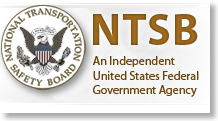

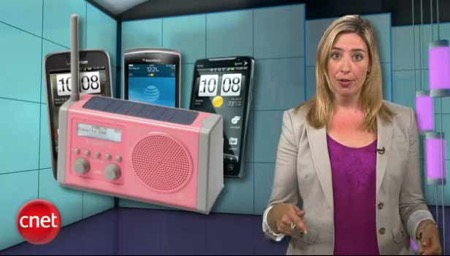

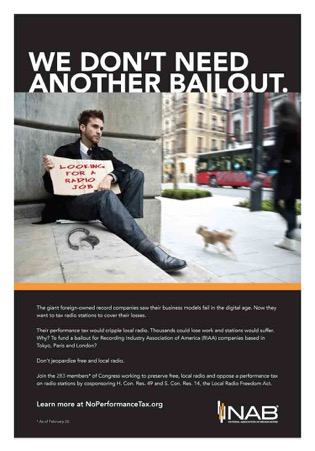



![Validate my RSS feed [Valid RSS]](valid-rss-rogers.png)

